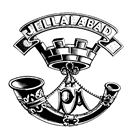
Arthur William Jewell

11th Battalion
Private 265384
 |  | |
| Somerset Light Infantry 11th Battalion Private 265384 | ||
| Killed in action 23rd October 1918 |
Arthur Jewell's Parents | ||
Father: Edward Jewell
Edward Jewell was born into the family of a carpenter called
William Jewell in Stoke Lane (near Stoke St Michael) in about 1851. Edward’s
mother, Anne, died in 1859, at which point Edward went to live with two uncles
and an aunt (his mother’s siblings) in Gurney Slade. We must assume that they
were better able to support him than his widowed father, who kept charge of two
of Edward’s sisters. In 1862, Edward’s father remarried and the family unit was
reunited along with stepmother Elizabeth (née Underwood). This marriage also
went on to produce further children and the 1871 census shows the family living
in Doulting with five children, including Edward who was an (unemployed)
carpenter, aged 19. Mother: Ellen Pitman
Arthur’s
mother, Ellen, was the daughter of a gardener on the estate of Hadspen House between Wincanton & Castle Cary.
In 1861 the census shows the family (parents and one brother) living in the
‘Lodge near Hadspen House’.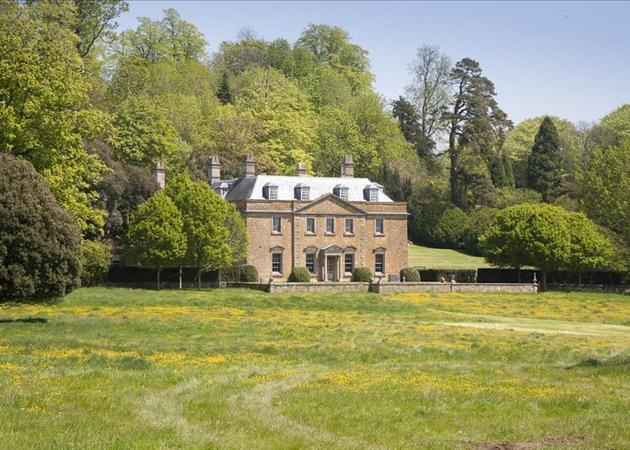 Hadspen House, between Wincanton & Castle Cary in Somerset (above).
Albert’s grandfather was gardener on
this estate and occupied one of the lodge houses in 1871 when Albert’s mother was 11. By 1871 Ellen was living in Bath, working as a domestic servant to the Bampfylde family living at 10 Darlington Street, Bathwick. Francis Bampfylde, head of the household, was Captain Adjutant to the Volunteer Riflemen. The remainder of the household was made up of his wife, seven children and Bampfylde’s father-in-law. 10 Darlington Street is the house which incorporates the archway | ||
The Jewell Family |
|
Arthur’s
parents Edward and Ellen married in December 1875. |
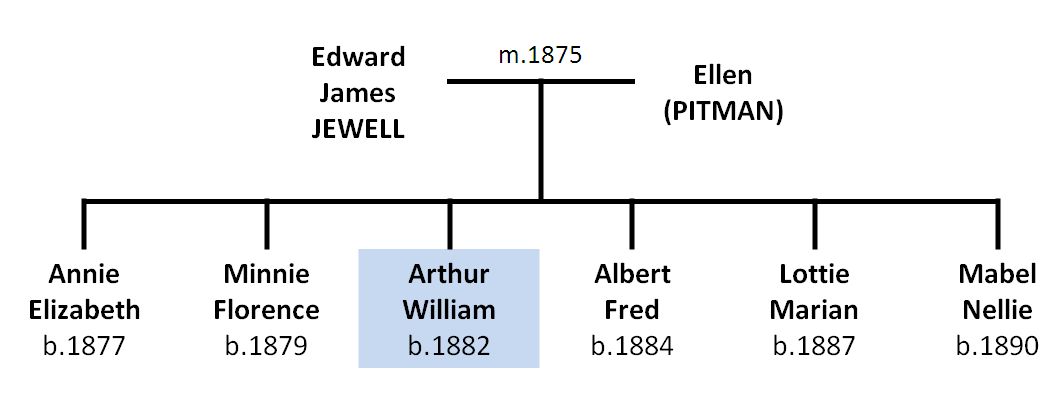 |
|
In 1881, the family is listed living at '2 New Trafalgar Place' (a terrace in Calton Road, a side street from the old Holloway) in the parish of Lyncombe & Widcombe with the two eldest children Annie & Minnie. Note that the first daughter bore the names Annie Elizabeth; these are the names of Edward’s mother and step-mother respectively. Arthur’s father continued working as a carpenter. This 1969
photograph has become iconic as representing the 'Sack of Bath', when
many areas of Georgian cottages were cleared. It features houses in
Upper Trafalgar Place in Calton Road, where the Jewells made their home
in the years following their marriage. [Image: BathInTime] In 1882 the Bath Directory shows the family had moved to 19 South View Road in Twerton, where they stayed for several years, including the period when Arthur, Albert & Lottie were born. 19 South View Road, East Twerton, where Arthur was probably born Later the Jewells lived for a short time at 39 Caledonian Road (just around the corner from South View Road), then even more briefly at 25 Crandale Road (off Moorland Road, 1894). |
|
Left: 39 Caledonian Road, East Twerton, where the Jewells lived circa
1889-1892 Right: 25 Crandale Road, home to the family in 1894. |
The
family then lived for five years at 3 Moorland Road (now the Ladbrokes betting
shop). Note that the terrace that now includes the Giant Party Shop, Sheriton
Jewellers etc. formerly had the address Moorland Terrace and was only later
renumbered to be included in Moorland Road. 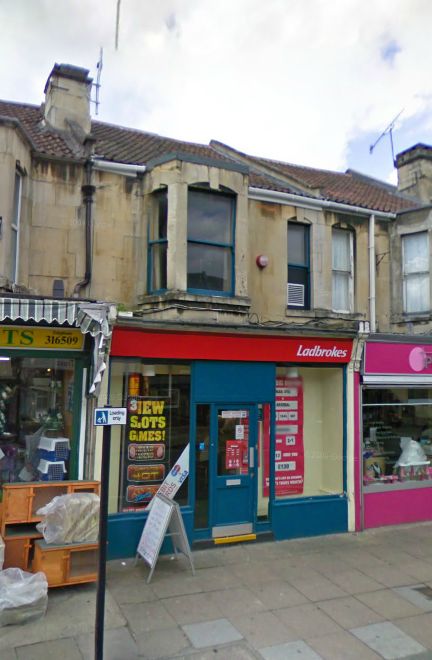 3 Moorland Road The Jewells' time in Moorland Road also dates to the time before the road consisted entirely of shops; many of the shops in Moorland Road are now housed in what were once people’s downstairs living rooms |
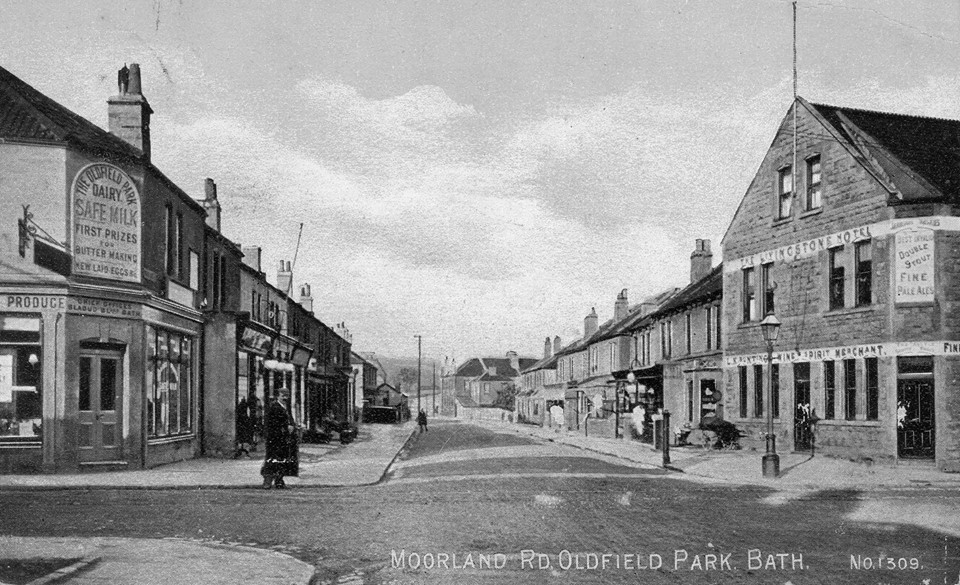 | ||
|
Moorland
Rd circa 1910, showing how what we now know as a row of shops
once incorporated bay-fronted dwellings. The Jewell family lived at the
other
(eastern) end of Moorland Road (behind the camera) in the years
1895-1900. Note the large building on the right, which was the
old Livingstone Inn, damaged in WW2 and later relocated to the corner
of Crandale Rd. |
|
By 1901, the family had moved to 56 Herbert Road; the census listed the parents and three youngest children. Arthur’s eldest sister (Annie) was now a cook, living with the Randolph family at a house called Bella Vista on Beacon Hill, Lansdown. His next-eldest sister (Minnie) was similarly in service as a housemaid in the household of two elderly sisters at 5 Russell Street; it is interesting to note that the cook in this household was a certain Fanny Jewell, Arthur’s aunt from Gurney Slade. 56 Herbert Road Arthur himself was living at 14 East Street in Warminster, lodging with the family of a wood turner called George Hill. He is listed under the name ‘William Jewell’ as a trainee hairdresser, aged 18, so it is possible or even likely that he was known by his middle name. Arthur’s Marriage
Arthur is one of the few men represented on the school plaque who married prior to serving in the War. In 1908 he married Lily Comley at St Swithin, Walcot. Lily was the same age as Arthur and grew up as the youngest of five children. Her father was a chimney sweep and the family lived in Trinity Square, in Walcot (behind London Street, roughly where there is now a car park accessed down the side of Hudson Steakhouse). Her occupation, as given in the 1901 census, was that of a ‘carpet upholstress’. 1908 Marriage certificate for Arthur Jewell & Lily Comley Interestingly,
Arthur's address on the marriage certificate is given as '2 Jone's
Buildings'. It's not clear where this address was, but directories of
the time show Arthur living at Stanley Place in Twerton. This was between the
Lower Bristol Road and the river. A 1947
newspaper report listed Stanley Place among addresses scheduled for demolition
due to being ‘unfit for human habitation because of disrepair or sanitary
defects which cannot be remedied at reasonable expense, or because by reason
bad arrangement of houses or streets, they are dangerous or injurious to the
health of the inhabitants’. Hampton & Sons Cabinet Makers was built on the
site of Stanley Place and the site was later occupied by the Herman Miller
factory (now Lidl). In the same year as Arthur & Lily were married, they had a daughter (who died the same year), followed by a son in 1911. |
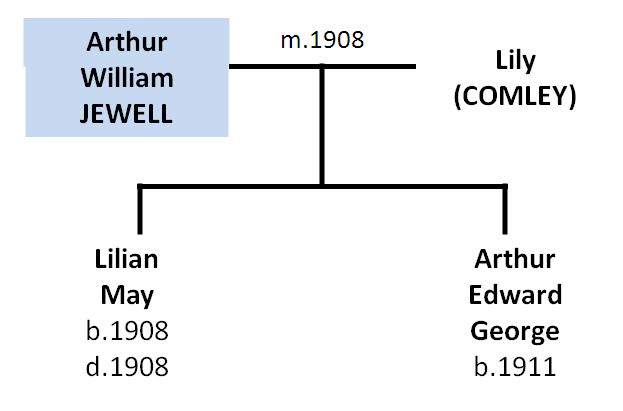 |
|
Also in 1908 (the year that Arthur married), his younger sister Lottie married. Her husband was Percival Bancroft Warren, elder brother of Claude Warren. The 1911 census shows that Arthur was working ‘at home’ and ‘on own account’, which suggests
that 13 Stanley Terrace comprised a barber’s shop on the premises. Wife Lily
was listed in the 1911 census living with her sister Alice’s family at 10
Hanover Terrace (off the London Road) when baby Arthur (junior) was less than a
month old. Arthur’s parents
eventually moved to 8 St Kilda’s Road, where they were listed in 1911, again
with the three youngest children. |
Arthur Jewell in WW1 | ||
Somerset Light Infantry, 11th Battalion
The following history is taken from the ‘Long, Long Trail’ website: In April 1915, the Territorial Force formed the 85th Provisional Battalion. It consisted of home-service and medically unfit men from the 4th and 5th Somerset Light Infantry, 4th Dorsets and 4th Wiltshire Regiment. The battalion also seems to have been referred to, possibly unofficially, as the ‘South Western Brigade Battalion’. By 1st January 1917 the battalion had moved, after period at Sandown Park and Seaton Delaval, to Whitstable. It was here transferred to the Somerset Light Infantry and renamed as the 11th Battalion. On 12th October 1917 it moved to Herne Bay and on 12th March 1918 went to Wrentham. The battalion embarked for France on 6th May 1918 under command of Lieutenant Colonel H. S. Woodhouse. The word ‘Service’ was added to its title and the battalion was placed under orders of 177th Brigade, in the 59th (2nd North Midland) Division. At this time the battalion consisted of B (medical) Category troops and was not considered for front line duty. Indeed, 59th Division was in the process of being rebuilt, so high were losses it had suffered in fighting against the German spring offensive in France. The battalion was first employed in digging trenches, but the need for men on the Western Front was such that it was converted into a fighting battalion and called upon to hold a reserve line sector south of Arras. Between 27th April 1918 and 16th July 1918, it was entitled 'Garrison Guard' Battalion, rather than 'Service'. About the middle of August, the war began in earnest for the 11th Somersets when they took over a sector of front line east of St Venant and Robecq. The enemy was beginning a withdrawal in this area and over the next days the battalion was in pursuit, going through Epinette and Lestrem. It was relieved for rest on 6th September. On 13th September the battalion moved into the front line once more, this time north east of Laventie. Nine days later, it was relieved and moved to billets at Bout Deville. Training recommenced and continued until towards the end of the month. On 16 September, a new commander (Lieutenant Colonel W. A. Gilliat) arrived. The next period of front line duty began on 3rd October, when the battalion moved to the line at Bois Grenier. Patrols went out, finding the enemy holding the position strongly. An attempt by several battalions to advance and clear a wood was met with heavy resistance and caused casualties. On 10th October the battalion was relieved for rest and moved back to Croix du Rome. Six days later the battalion began a series of moves that took it to the crossing of the River Escaut (Scheldt) and the seizing of key bridgeheads. In this move, the battalion was among the first British troops to enter Lille after four years of German occupation. A patrol of troops of the 11th Somerset crossed the river by raft, under fire, near Templeuve. On the far bank the enemy was in considerable strength and determined to hold out. In the ensuing fighting, a shell exploded in a barn being used as shelter by C Company, causing the death of nine men with another nine wounded. Further patrols probed across the river, bringing back prisoners, captured guns and useful information. The battalion was relieved on 26 October and moved to billets at Hulans. Given that Arthur Jewell was about 36 in 1918, it is perhaps unsurprising that he was originally in a battalion that was not originally destined to see front line action. | ||
Arthur Jewell's Death | ||
|
Private Arthur
Jewell died on 23rd October 1918. The final paragraph, above, covers
the period that includes this date. More exact details of the circumstances of
his death are not known. Arthur Jewell died less than four weeks before the November Armistice. He was about 36 years of age; much older than the average age of combatants. The Bath Chronicle & Weekly Gazette of 9th November carried this photo in its ‘Roll of Honour’: | ||
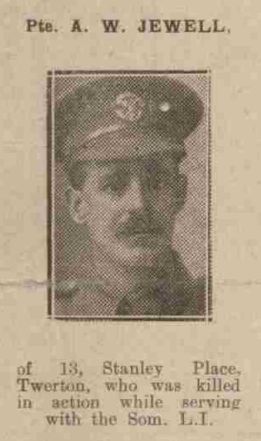 |
Burial | ||
|
Private Arthur Jewell is buried in Tournai Communal Cemetery (Allied Extension). As is often the case, this was a re-burial; records show that Arthur was previously buried at Ramegnies-Chin churchyard. An amazing photograph of Arthur Jewell's original grave at Ramegnies This old postcard shows Ramegnies-Chin churchyard just after World War 2. History repeated itself and the 21 war graves from that later conflict can be seen in the form of the small wooden crosses.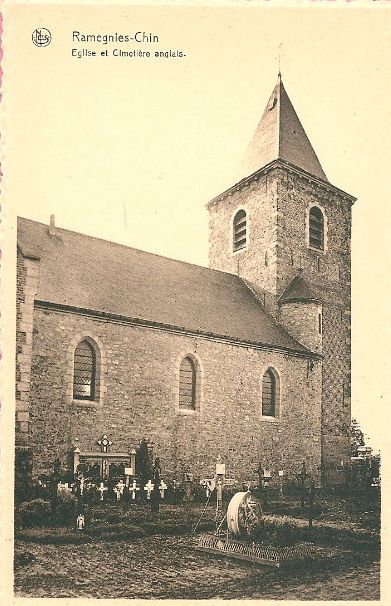 Arthur was later reburied at Tournai. From the Commonwealth War Graves Commission website:Tournai was captured by the German II Corps on
23 August 1914, in spite of resistance from a French Territorial Brigade, and
the town remained in German hands until it was entered by the 47th (London) and
74th (Yeomanry) Divisions on 8 November 1918. The 51st (Highland) Casualty
Clearing Station arrived on 14 November and remained until 20 July 1919. During
the occupation, the German sick and wounded were nursed in the
"Asile", whilst the Commonwealth and Allied were cared for in the
Hopital Notre-Dame.
The (Southern) Communal Cemetery, in the Faubourg-St.Martin, was used and extended by the Germans, although the graves were later regrouped by nationality and some were brought in from more than 60 other cemeteries in a wide area around Tournai. | ||
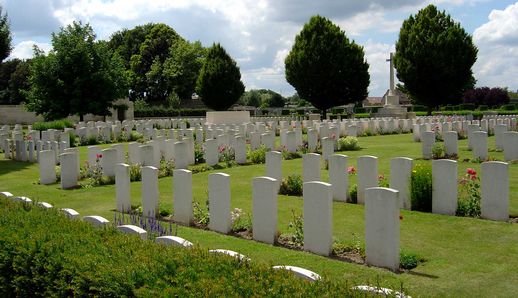 | ||
|
Tournai Cemetery. [Image: www.inmemories.com] |
|
In June 2019, Tournai cemetery was visited by Bath resident Mike Sumsion, who took with him a memorial cross inscribed by pupils from Oldfield Park Junior School to place on the grave of Alfred Jewell. A small, but meaningful act to show how we try to live up to the vow 'We Will Remember Them'.
Our thanks go to Mike for helping with this act of remembrance and for supplying the above photographs. |
Decoration | ||
|
Private Arthur Jewell would have been posthumously awarded the British
War Medal and the Allied Victory Medal. | ||
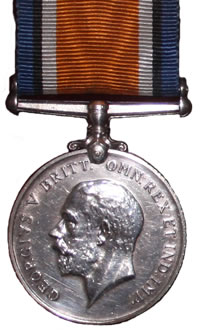 | 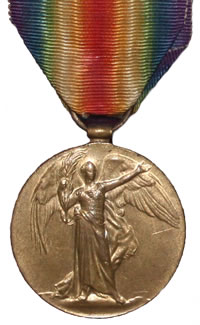 | ||
| British War Medal 1914-18 | Allied Victory Medal |
Commemoration | ||
 In addition to his inscription on the South Twerton School memorial, Arthur Jewell is commemorated as follows: | ||
|
Bath War Memorial See separate page for details of the Bath War Memorial. Arthur Jewell is not currently listed, but it is clear that he should be. We will be making enquiries about his inclusion on the memorial. |
| Watch this space |
|
Twerton Parish Memorial The Twerton War Memorial is situated next to the footpath that skirts the northern edge of the church grounds at St Michael's. Arthur's residence at Stanley Place fell very much within the parish boundary. |
| The inscription that we would do well to live up to: |
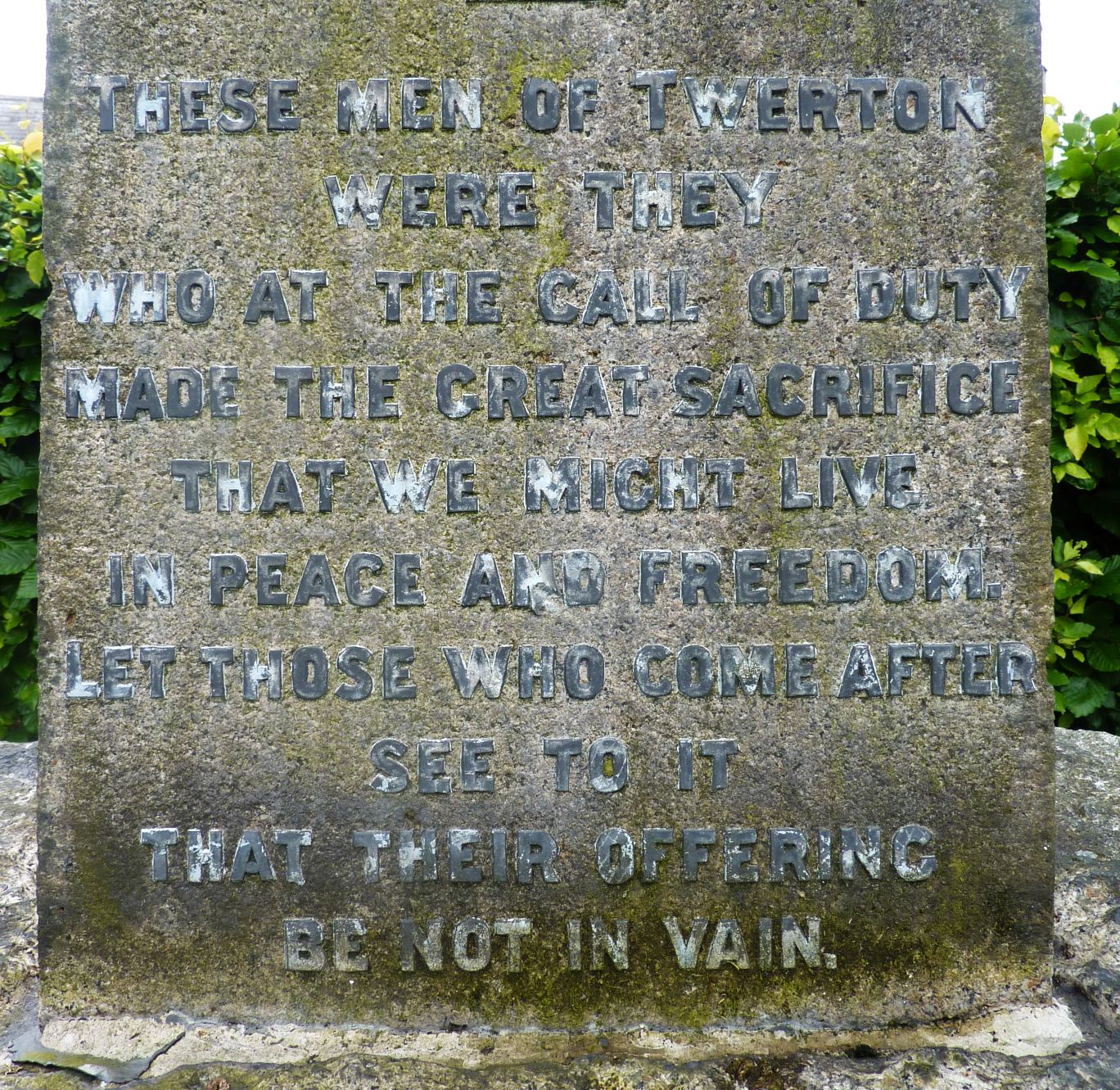 |
| The inscription for Arthur Jewell is sadly mis-spelled. This could potentially be rectified if the memorial is renovated (which it needs). |
 |
Further Information |
The Jewell family beyond the war
The Bath Directory shows that Arthur’s wife Lily went on to run the hairdressing business at 13
Stanley Place after Arthur had died.
It has been great to make contact with Sarah Nicol, who is the great-granddaughter of Arthur Jewell. Many members of the family still live locally. Sarah came to the Oldfield Park Junior School WW1 Memorial exhibition in July 2015 and thoroughly enjoyed seeing the amazing work done by the pupils to commemorate Arthur Jewell and the other servicemen. Arthur Jewell's great-granddaughter, Sarah Nicol |
Living RelativesIt would be great to hear from any other living relatives of Arthur Jewell. Of Arthur's siblings we know:
Please get in touch!If you have any further information on Arthur Jewell or want to suggest corrections / improvements for this page, please use the Contact page to get in touch. |